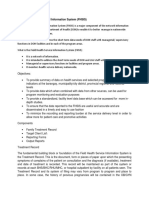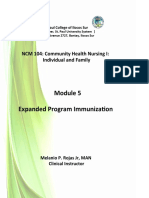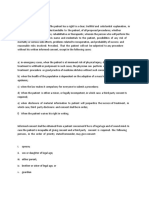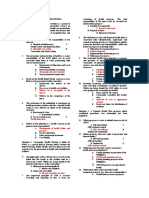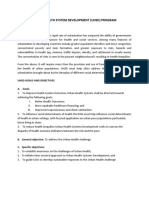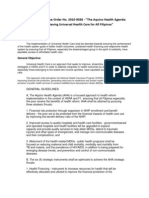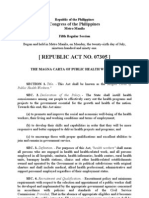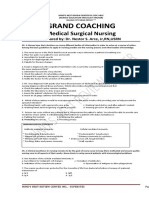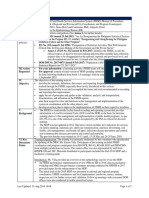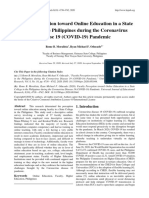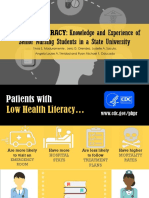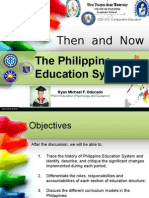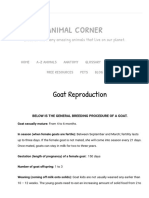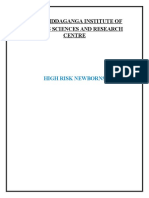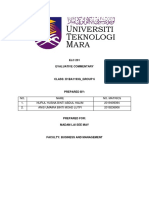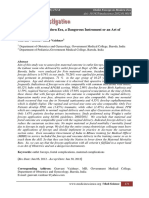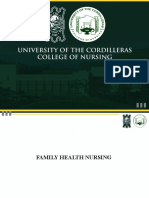The Field: Health Services Information
The Field: Health Services Information
Uploaded by
Ryan Michael OducadoCopyright:
Available Formats
The Field: Health Services Information
The Field: Health Services Information
Uploaded by
Ryan Michael OducadoOriginal Title
Copyright
Available Formats
Share this document
Did you find this document useful?
Is this content inappropriate?
Copyright:
Available Formats
The Field: Health Services Information
The Field: Health Services Information
Uploaded by
Ryan Michael OducadoCopyright:
Available Formats
MonographNo.
4
The
Field
Health
Services
Information
System
ItsRole
inDecentralizing
HealthServices
inthePhilippines
Monograph No.4
The
Field
Health
Services
Information
System
ItsRoleinDecentralizing
HealthServices
inthePhilippines
By Manuel 0. Sta. Maria
Management Sciences forHealth
TheFieldHealthServices
InformationSystem :
ItsRoleinDecentralizing
HealthServices
inthePhilippines
CSPMonographNo.4
Published by
TheChild Survival Program,
Department of Health,
Republic ofthe Philippines,
with theassistance of
the United StatesAgency for
International Development
(USAID).
Manila 1993
Editing,designand productionby
Beaulah P.Taguiwalo
TheFHSIS: ItsRolein DecentralizingHealthServicesinthePhilippines
Contents
Page7 Abbreviations
used
Page9 Introduction
Page11 1 TheFHSISinperspective
Page13 2 TheFHSISanditscomponents
Page18 3 TieFHSISandtheLGO
Page23 4 TheFHSISanddevolution
Page26 5 TheFHSIS,APBHP,andotherDOH
technologies
Page29 AnnexA
Samplepagesof aTargetClientList(TCL) ledger
Page33 AnnexB
Page35
List ofFHSISReports/Forms
(RFs)
SamplesofFHSISReports/Forms
(RFs)
Page39 AnnexC
SamplepagesofaSummaryTable(SumTab)
Page45 AnnexD
SamplesofSimplifiedOutputTables(SOTs)
The FHSIS:ItsRoleinDecentralizingHealthServicesinthe Philippines
Abbreviations
used
BHS Barangay HealthStation
CDD Control ofDiarrheal Disease
DOH DepartmentofHealth (Philippines)
EPI Expanded ProgramforImmunization
FHSIS Field HealthServices Information System
HIS Health InteiligenceService
I/FTR Individual/Family
Treatment Record
LGC LocalGovernment Code
LGO LocalGovernment Official/s
LGU Local Government
Unit/s
MCH Maternal and Child Health
MW Midwife
NCR NationalCapital Region
OT OutputTable/s
PCO PHOComputerOperator
PHN Public Health Nurse
PHO Provincial Health Office
RF Reporting Forbms; Reports/Forms
RCO RHOComputer Operator
RHO Regional Health Office
RHU RuralHealth Unit (Municipality)
SOT Simplified OutputTable/s
SumTab SummaryTable
TCL TargetClient List
USAID United StatesAgencyforInternational Development
WHO World Health Organization
TheFHSIS: Its Roein Decentralizing t'althSeriesinthe I'lilippiles
Introduction
TheField HealthServices Information System(FHSIS) is theonly
information system for public health operatingthroughout the Philippines
today.Nowhere in tilegovernment systemcan onefind an information
system thatreaches tothevery roots ofthe political/social structure -- the
barangays. h was implemented afterconsiderable time spentstudying tile
country's public health information requirememts and thereaftersttdying
and installing the systemdesign and finally training its implementors and
users.
Barely a yearin full operation, the F1 ISIS had tocontend with a
developmentof national importance: the implementation of the Local
Government Code (LGC), whichdevolved themanagement of public health
facilities totie LocalGovernment Units(RGUs).
Because FHSISis facility-based, tileI.GC presented a newdesign
consideration. -lowever, because ofthe inherent strengthsofthe recording
and reporting subsystens of theFl-ISIS, thesystem hasbeen assessed as
workable by thevery people who must oversee it in the regions.
National information systems,it is said, settledownafter five years.
FHSIS isstill in its infancy, and it is still in tile process ofadjustment and
improvement. But because it isa system developed specifically forthe local
community, it isonly right thatin theprocess ofadjustment and
improvement, itadjusts and improves in thedirection ofeffectively serving
and promoting thedevolution ofhealth services.
,,9
The FHSIS :ItsRole i Decent ralizingIlealth, Servicesin the I'hlilippines
The FHSIS
inPerspective
"The firstattemps at puttingtogetheraninformation
systemforthe DOH beganas a responseto theneedfor
streamlining an existingreporting system that,midwi es
complained,,wasburdensome,time-consumning,and
ultimnately evenlprevented them
from dischargingtheirseniice
deliveryfunctionsfully."
F ISIS istheresultof
thejointeffortsof many
sectors within and
outsidethe Department
ofHealth (DOI I).The
first attenipsat putting
together ani nformation
svstem forthe DOII
began asaresponse to
theneed forstreamlining
an existingreportingsystem
that, midwives complained, was
burdensome,time-consumIing,
andultimately evenprevented
them from discharging theirservice
deliveryfunctions fully.At least two
attemptsweremade between 1976and
1982 tocreatean information system thatwould orchestrate allexisting
reports,butneitheroftheseattempsprospered beyond thedesign stage.
A health information system had beenconceptualized in 1987by the
World Health Organization (WHO).The present information system - the
FHSIS- wasdeveloped primarily becauseofagrantprovided by theUnited
States Agency forInternationalDevelopment (USAID) to theWHO in 1988
TheFHSIS:ItsRole inDecentraliziu HealthServicesinthe Philippines
tocontinue what it had started. WHO consultants spentthewholeyearof
1988 conducting workshopsamong program areas, gathering health
workers' information requirements, determining the readinessofmiawives
fortheFHSIS, formattingand testing reporting forms, preparing the
procedures manual,designing the training program, and pre-testingthe
system in Regions 4 and 7. By 1989, themanuals and forms had beenrevised
and finalized; training sessions had been conducted forsystem
implementors, which lasted until the middleof 1990); and thesystem was
being implemented in five regions.Two years later,by April 1990, the
system was operational inall regions except theNational Capital Region
(NCR). (Becauseofthe urban setting and uniqueenvironment in the NCR,
pre-testing had notbeen concluded at thetime.Implementation ofthe
system in the NCRfinally took place in 1991.) The DepartmentofHealth,
through the USAIDChild Survival Program (CSP)grant,continued
implementing the system in 1990and, toward thelatterhalfofthe year,
acquired the servicesof an advisortoassist the Health Intelligence Service
(HIS) manage thesystem.
The Fl-ISIS was conceived asacomputer-based systemfromthestart. An
essentialcomponent was thedevelopment ofcomputer programs for data
entry, processing, and report generation, which started in late 1989. The
resultingsoftware was then installed in the provincial health offices (P-Os),
which had been identified beforeoand as the systern's processing nodes.The
installation ofthe software in the PHOstook place in 1991, althoughseveral
versions of thesoftware were made afterwards,between 1990 and 1992, to
satisfy the requirements ofthe system. After thesoftwarehasbeen installed,
training sessions wereconducted forcomputeroperators.Since there were
noofficial positions forcomputer operators in thePI 1Os, personnel
identified fortraining were eitherpulled outfrom existingassignments or
simply given additional duties. 13mid-1991, mostofthe75 provinces were
able to producetheir first computer-generated
output tables (OTs).
Initial monitoring ofthe system wasdone in early 1991. Theconclusion
arrivedatwas that inspiteoftechnical problems,the midwivesappreciated
thesystem, particularly in relation to theirwork thathad todo with
recordingand reporting.
A memorandum issued in 1991 by the DOH Undersecrtary and Chiefof
Staffis particularly relevant to thecharacter and development of theFHSIS.
Among otherthings,it pointed out that theFHSIS is theonly reporting
system sanctioned for all programscovered by theFHSIS, and thatany
changes in thesystem cannot be undertaken until aftertwo yearsof its full
nationwide imp!ementation, which would be theyear 1993.
'-7
12
2
TheFHSIS: ItsRole inDecentralizing HealthServicesinthe Philippines
TheFHSIS
anditscomponents
"Therearefivecomponent
activitiesthattogethercomprise
theFHSIS.These arerecording,
reporting,dataentry, processing,
andtheproductionand
dissemination
ofoutput
tables."
Objectives
oftheFHSIS
The FHSIS has the following
objectives:
" Toprovide summarydata
onhealth service delivery
G
and selected program
accomplishment
indicatorsat thebarangay,
municipality/city,
district,
provincial, regional, and
national levels;
"To providedata which,
when combined with data
fromothersources, caln be
used forprogram monitoring
and evaluation purposes;
" To providea standardized,
facility-level database which canbe accessed for more in-depth studies;
"To ensure thatthe data reported are usefuland accurate and are
disseminated ina timelyand easy fashion; and
" Tominimize theburden ofrecording and reportingattheservice delivery
level inordertoallow moretime for patientcare and promotive activities.
'All
TheFlISIS: ItsRolein DecentralizingHealt/hServicesinthePhilippines
Programscovered by theFHSIS
The Departmernt ofHealth hasanetwork ofinformation systems, and the
FHSIS wasconceived as a major component of thisnetwork. In particular,
theFHSIS isa facility-based systemdesigned toprovide basichealth-service
delivery data for the following programs:
" Maternal and Child Health (MCI ),which includes Pre-natal Care,
Post-partum Care, Expanded Program on Immunization (EI),and
Controlof Diarrheal Diseases (CDD)
" Nutrition
* Family
Planning
* Tuberculosis
" Malaria
Control
" Schistosomiasis Control
" Leprosy
Control
" Dental
Health
" Environmental
Health
" Vital Statistics,whichincludes Natality, Mortality, andPopulation
" Notifiable Diseases
* Logistics
The component activities oftheFHSIS
Thereare five component activities thattogethercomprise the FHSIS.These
are recording,reporting, dataentry,processing, andtheproduction and
dissemination ofoutput tables.
Recording
Two basicrec(,-ds arekept inthe health facility: theIndividual/Family
Treatment Record (I/FTR)and theTargetClient List (TCL).
The I/FTR documents thepatient's consultation with the health
personnel. It isa record ofthe patient's symptoms/complaints and the
corresponding diagnoses, treatments,aid datesofencounter with the health
provider. Some programs have theirown recording specifications, buteach
facility isencouraged tomaintain a file foreach individual/family as part of
the system.The TCL, on theotherhand, isa facility-based ledger which
records healthservices rendered tospecific patients (clients, "targets", or
"eligibles")
and assuch servesseveral purposes:
6(
14
TheFHSIS.ItsRole inDecentralizing
HealthServicesin thePhilippines
1. Tohelp thehealth service provider planand carryout patientcareand
service delivery;
2. Tofacilitate themonitoringand supervision ofservice delivery
activities;
3. Toreport services delivered;
4. Toprovide a clinic-level data basewhich can beaccessed for further
studies.
The client lists maintained by the healthfacility are:
1. TargetGroup L.stforEPI
2. Target/Client
List forChildren 0to 59months
3. Target/Client
List forNutrition
4. Client List for Prenatal Care
5. Client Listfor Postpartum Care
6. ClientList for Family Planning (Non-surgical
Methods)
7. List forTB Symptomatics
8. Client List for TBCasesunderShort Course Chemotherapy
(SCC)
9. Client ListforTB Cases underStandard Regimen (SR)
10. Client List for Leprosy Cases
Specific instructions for recording data in theTCLs arefound in the FHSIS
Manual ofProcedures.
Reporting
In the FHSIS,data and information are transmitted fromone reportingunit
to another primarily through the FHSIS reporting forms (RFs). Majorityof
the RFs areprepared and submitted either monthly orquarterly.There is
oneRF thatis prepared weekly, there areseveral that are prepared annually,
and a fewthat areprepared upon theoccurence ofspecific events. In
addition, the FlISIS RFalso recordsservices which arenot"client"-specific
and therefore cannot be found in the TCL. A listofthe FlISIS RFsand their
schedules ofsubmission canbe found in Annex A, together with asample of
some of theRFs.
The RFs haveboxes for tallyingthe services that have been provided
during theperiod for which the report isbeing prepared. This tallybox
facilitates therecording and transfer ofaccurate data. Complete guidelines
for fillingup the FISIS RFsare found in the FISIS Manual ofProcedures.
RFsare filled upby all midwives (MWs) in theBarangay Health Stations
10
TheFHSIS:Its Rolein Decentralizing HealthServicesin the Philippines
(BHSs). Thedatais then transferred onto a Summary Table (SumTab),which
theMidwives keep on file ill the BFIS orhealth facility.TheseSumTabs
comprise thedatabase forthe Midwives.Sample pagesofthe SumTab are
found inAnnex B.Finally, tileMidwives submit their Rsto thePublic
Health Nurse (PHN) forvalidating and forwarding totile Provincial Health
Office (PHO).
Data EntryandProcessing
The PHO isthe processingnode ofthe FlISIS. It receives all the RFs fromthe
rural health units(RHUs) ofmunicipalities and fromthecity health offices
(CHOs)ofthecomponent citiesin tileprovince, anda designated Provincial
Computer Operator (PCO) in tileP1-1O performs thedataentry using
DOH-developed software. The RFs submitted to the P10serve as thesource
documents for data entry.When the PCOenters thedatain thePHO
computers,the newly-entered data automatically updates and consolidates
all previous records ofeach public health program on a year-to-date basis.
The PCOsubmits soft copies (diskettes) tothe Regional H-ealth Office
(RHO) forfurtherconsolidation and processing by theRI-1 Computer
Operator (RCO).TheCHOsubmits directly tothe RHO.
ProductionandDisseminationofOutputTables
Afterall thedata from allthe RFs havebeen entered, the Provincial
Computer Operator (PCO) produces theOutputTables (OTs)using
computers and printers located in the Provincial Health Office ortheCity
Health Office.Since theOT isthe productof the softwareusingcurrent data,
itis a mirrorofall thedata submitted bythe different reporting unifs. In
addition, it also includes calculations thatare automatically madeby the
PHOcomputer,based on predetermined and pre-defined indicators.
Copies oftheOT aregiven toall District HealthOffices (DI-Os) and Rural
Health Units(RHUs) forthe useof health managers in monitoring,
supervision and administration.The RHO likewise produces consolidated
OTs from thePHO diskettes for its ownuse in monitoring,supervision and
management. Technical coordinators atboth the PI-Oand RHO levels are
also given copies of theOTs.
The FHSIS wasoriginally intended toassist tile health service delivery
managers oftheDOI-. Because of the passageofthe Local Government
Code(LGC) in1991 and tileprojection ofits full implementation in 1993, the
focusofthereporting system had to shift in part.
16
TheFHSIS:Its Rolein DecentralizingHealthServicesin thePhilippines
Under the LGC, the management and provision ofhealth services was
transferred tolocal governmentofficials (LGOs). Consequently,
the FHSIS
now servesthe LGOrather thanthe DOH. While theelements ofthesystem
remain basically unchanged, thewhole system mustnow be viewed ina
newway, keeping in mind that its primary user and implementor isnow the
LGO, with the DOll merely providingappropriate technical support.
Underthe LGC, it hasbecome more necessary thanever that theelements
of theFl-ISIS all operate at thelocal government unit(LGU). Fortunately, the
designers ofthe F-ISIS gave primary importance tothe design oftheTarget
Client List (TCL), which hasnow become theprincipal data baseat theLGU.
With only minor modifications in the TCLs and RFs, reporting, processing
and theproduction ofreports can now take placeat the LGU, sometimes
even withoutinvolvingcomputers at all.
"UndertheLGC,themianagemnentandprovisionofhealth
services wastransferredtolocalgovernmentofficials...
"While theelementsofthesystemremainbasically
unchanged,thewholesystem mustnow beviewed inanew
way,keepinginmindthatitsprimaryuserand
implenentorisnow theLGO...."
The FHSIS:Its Rolein Decentralizing HealthServicesin tiePhilippines
3
The FHSIS
andthe LGO
"...the FHSISisa
anexistingsy~stemn
thatis
immediately
availableto the
LGO. Hecan use
thesy/stemn asitis,
orhe canadapt it
toaddresshis
otherconcerns."
TieLGOand
healthservicesfor
thecommunity
Under theLo-al Government Code,theresponsibility for themanagement
and provision of health services to thecommunity hasshifted to theLGO. In
order tocarrythis out,the LGOmust effectively address thefollowing
I. availability ofservices and manpower
2. qualityofservices and manpower
3. readiness ofresources when needed.
The LGO may find it useful, ifnot necessary, toknow theanswers tothe
following questions:
1. Whoare the beneficiaries ofthe health services?
2. Where are thev located?
3. Whatare theservices that they need?
4. Flow much load can the midwife bear?
5. What resources support -- financial, inkind, transportation -- does he
need toeffect theseservices?
18
TheFHSIS :ItsRote in DecentralizingI hwlthServic,'sinthePhilippines
The FHSIS provides theanswers to these questions,and all the LGO has to
doisuse it.
Thehealthsituationin thecommunityasshoVnby the
TCL andtheRFs
The Target Client List(TCL) isa veritable fixtureof thebarangay health
station (BIiS), inv'ariablv prominently displayed on a table.TheTCL is a
carefully tended document; it is in a sensethe definitive document regarding
the health situation in the community, and the midwives in particular are
very much aware of how important it is. It is always carried in themidwife's
kit and broughtalong during the hervisits to her''targets" or "clients".
Storiesare toldabout thecare that midwives havedemonstrated towards the
TCL, involving floods, fires, capsized bancas, runaway horses,etc.
The Target Client I1st (TCI) is in the form ofa ledger that records all
services, covering varioushealth programs, that are rendered tospecific
persons, patients orclients. Services which are not client-specific are directly
recorded in the tally/reporting torm or RF. Indeed, it can trulybe said that
the TCI. and the Rlsare, together,comprehensive and faithful dcocuments of
the service history of the 131IS. Specifically, the TCI. contains a record of
I. all pregnant women eligible for pre-natal care/service within the
catchment area
2. all women delivering babies within the catchment area
3. all eligible men and women aged 15-49 receivirz family-planning
service provided by the reporting facility
4. all children from birthupwards eligible fLrimmunization against the
seven immunizable diseases
5. all children aged 0-59 monthsclassified as health-risk children
6. all pre- chool children 0-83 months diagnosed as second- or
third-degree malnourished and risk-children in need of
food /micronutrient supplementation
7. all sy'mptomatics fortuberculosis falling under thedefinition madeby
the TB program and identified by health workers in consultations at the
clinic and ir,visitations tothe community/ field
8. all leprosy cases from any source.
The RFis basically a data-transmission medium. Ilowever, some formsare
practically extensions ofthe TCL because they record data thatare not
person- orclient-based and are therefore not included in theTCL.
419
The Fl-ISIS:ItsRole inDecentralizing Health Servicesinthe Philippines
Examples of thisare:
1. numberofpatients seen with an episodeofdiarrhea
2. number ofstool specimen examined forschistosonliasis
3. numberof malaria suspects identified
4. numberof streams cleared and seeded, numberofbioponds
constructed, and number ofhouses sprayed for malari,,
5. number of services, treatments, and consultations not recorded in the
TCI. orother RF
6. number of laboratorv exams
7. number of births
8. number of maternal, neonatal and ;tillbirth deaths; numberofdeaths by
age, sex and cause of death
P. population byage, se\; number of MCRA (married couple of
reproductive age)
10. iuimber ofdental patientsand services ren-lered
11. household survey on environmlental sanitationl
12.clinical i.Iformation and laboratory results forsexuall, transmitted
diseases.
Itis really quiteeasy for the local governent official (I.GO) to seethe
health situation of thecommunity by examiningthe TCL and the Rls.Some
examples ofthe kind oif information that the L.GO would be able toget are
I.the clientbi-se ofhealth services identified as individuals and also
presented asdemographic profiles
2. tile nat:-ireand capabilitiesof the health services
3. tiequality .4health services
4. the scope ani volume ofworkof the health worker,particularly the
midwife
5. the geographic reach of themidwife (itis an established fact thata
midwife visits all thebarangays in hercatchment area)
6. the historyOf services gi.,into each client
7. the quantityof logistics andresources used.
In addition, there is the Summary Table (SumTab). Data in theTCI. and the
Rsart summarized inthe Sumiab,which stays in thehealth facility, beit a
barangay health station, arural health unit, amajor health center in the city,
or an outpatient department ofagovernment hospital. The SumTab has
twelvecolumns. Each column corresponds to one month of theyear, and it
ct)ntains asumlaryofall the data that the midwife submitted in the RFfor
thatmonth. All the LGO needs to do in order togauge thc performance of
'5
20
ItsRole in DccelttraliZin' TheFSIS.-
Ih0althSerVicS in the Pilippines
tilhealth facility within hisarea "...theLGO Will...haze
ofresponsibility isto study the tomake a lot of major
SunTab.Ofco.rse,because the managementdecisions
SuniTabcontains rawdata, it forwhich 1w willneed
requires further processingfor othersources of
the data to ,e)omemeaningful
information...
information.
... theFHSIScan
effectivehl reduce his
The TCL, theSum Tab, work byhalf."
andtheSOTs
When an L(G. visitsthe I3HS, he
willfind that there are two
documlentsthere that together willbe ableto provide him withawealth of
informationabout the health situation in hiscommunritv :theTCL, and the
Su mTab. TheSiimTab, Which is tile database Of the facility, willbeable to
providehim with raw data.This raw data can in turn be complementtd by
details that can be founl illthe TCI..
To rounI out hisunderrtanding of the Snmiabdata, theI.Ocan also
refer to the SOTat tile Il IS. Ilowever,abetter rterence document forthe
LGO)of thenunicipalitywotId b-etheSOTprepared at theRI IU rather than
the SOT prepared at the B;I ISitself.This isbecause thedata in the RI IUSOT
covers tile whole municipality; therefore, it yieldsbetter indicatorsthan the
indicatorsin tile the same manner, the better reference
BIIS SOT. Ill
document for tile provincial ILGO wou dbe the provincial SOT.
Iiformation that canbe fotnd inthe SOT ilnclude:
* year-to-date percent accomplishments 4f each progran
* cumulative coVer'age Oftile or"clients" ofeach program in the
t,targets'
community
* assessment ofwork to be finished for the remainder ofthe year
* numberofbirths
* numberofdeaths and causes ofdeaths.
Armed with theabove information, theIGOwould bebetterequ,ippedto
deal with the three aspectsofhealthservicedelivery that had been identified
earlier :avalabilityofservicesand manpower, qualityofservicesand
manpower, and readinessofresourceswhenneeded. More specifically,the
LGOwould be inabetter positiontoanswer thefollowingquestions
... ... ..... ........ ..... .... .. .... ....
TheFHSIS.:ItsRolein DecentralizingHealthServicesin thePhilippines
Knowing howmuch morehas tobe "A new challeinge
covered and accomplished for the forhealthworkers
year, howcan the LGU sustainor -- particularlythe
make available the services and PHN andthe
manpower for thisyearand the MHOatthe
succeedingyears? mnunicipallevel
Knowing what services tosustain or anlthePHOand
makeavailable, how can theLGU theprogram
ensure thequality oftheseservices? coordinator;attile
What resources can the LGU make provinciallevel.--
available toguarantee diequality of 1o) liesinhelping
theseservices?
theLGO
It canonlybe expected that the LGO
appreciateanduse
tieFHSIS."
will have variousotherconcerns and
priorities. ie will have tomake a lot of
majormanagement decisions forwhich
he will need othersources of
information, othersystems,other
management tools.The F-ISIS caneffectively reduce his workby half.
It cannot beover-emphasized that the FiSISis a an existing system thatis
immediately available tothe LGO. Ilecan use the systemas it is, or liecan
adapt it toaddress his otherconcerns.As it is, the FlISIS already yields
health indicators useful tothe LGU, such aspopulation,births, social
hygiene,and causesof deaths. By adaptingand expanding the FHSIS,it can
become even moreuseful. For example, the SOTs can beexpanded to
includeother concernsidentified by theLGO. Or,other tablescan be
designed sothat health indicators canbe examined side by sidewithother
LGU indicators such as financial indicatorsorindicators that have todowith
materials, infrastructure,peace and order,and others.
Indeed, the LGOcould even eventually conclude,and rightly so, that with
theFHSIS alonelie can geta good grasp ofthe healthsituationofthe
communitythat he isserving. A newchallenge forhealth workers --
particularly the P1IN and the MI-10 atthemunicipal level and theP1-10 and
the program coordinators attheprovincial level. -- nowlies inhelping the
LGOappreciate and use theFHSIS.
22
4
The FHSIS:ItsRole inDecentralizing
IhealthServiccsin thePhilippints
The FHSIS
anddevolution
"The FHSISis
anexisting and
Workinghealth
information
systemthatcan
help 'heLGO in
themanagement
andprovisionof
healthserviL.s
inthe
Comnunity."
TheFHSISis anexisting
and working health
information
system thatcan
help the LGOin the management
and provisionof healthservices in
thecommunity.
Thesystem -- the
FHS!S-- and the tools -- the TCL,
the RFs, and the SumTab-- are at
thethe LGO's disposaland it isup to him /
toeitheruse themoradapt them.
In order to make the FFISISadapt tothe
changes brought about by the Local
Government Code, the Fl-ISIS technical
staff formedstudy teamsandundertook
activities aimed atimproving, simplifyir,,and
making thesystem more responsive and relevant todevolution.The
direction ofstudy followed two tracks: theoutputsof thesystem and the
architecture ofthe linkages.
the Philippie's
TileFHSIS:Its Roleinl DecentralizingHealthServicesill
ImprovingandSimplifyingtheOutputTables
IfFHSIS were a television set, the Output Tables(OTs)would be theimages
on thescreen. TheOTsare the tangibleand usableelenents of the system
that enablethe users to graspthe information that thesystem offers.
However,there were acouple of problems with the production oftie
OTs. First, the OTswere notavailable in many provinces for along time
because oftheinability ofthe computers toproducethem. Second, for those
provinces that were tortunate enough toproduce theOTs, the users found
the0 Fsforbidding, intimidating, and generally notuser-friendly. Filled
with longtables and nm1erous colunms in very small print, the OTswere
really intended tohelphealth workers in provinces, cities, municipalities
and barangays analyze theiroperations and thereafter takeaction to
improve service delivery, supervision, monitoring and evaluation. It might
have helped if theOTs had first been produced and disseminated toall
districtsand RI lUs just toget feedback for the reportingsystem.
TheIlealth Intelligence Service ( IS)technical team worked towards
improving theOTs with thesetwoproblems in mind. Tihe team focused on
two objectives: to simplify and shorten the tablesas much as possible,and to
make tieOTsgenerally mo;e user-fi endly. Therewas actuall' athird
objective, which was to reduce the over-dependence on computers in the
production oftheOTs. As it turned out, thisthird objective wasmet in tie
courseof attaining the firsttwo objectives.
Since the 01'sare program-oriented, it was theprogram managers that tie
HISteam primarily worked with.The IIIS teamasked the program
managers to aim towards reducing theOTs toeight colunnsorless, and this
meant drastically reducing their information roquirements. Ittook a seriesof
negotiations todesign asimpleroutput table for each program, burin the
end it all resulted in whatare now called Simplified OutputTables orSOTs.
Itmust be noted that this time, in the process ofdesigning theSOTs, the
requirements of the LGUs were taken intoaccount.
TheSOTs now average ten columns,and the text is printed in bigbold
letters. The SOTs were also designed so thateach onecan fit intoone page
measuring 8.5 by IIinches, which are the dimensions ofasheet ofstandard
short-size bond paper. Furthernmre, theSOTs donot have to be generated or
printed by acomputer. When the SOTswere shown to the PIlOs in late
1992, the unanimousagreement was that theSOTs are now indeed simpler
and more user-friendly, and thatthere was every reason toexpect that they
will also appeal tothe LGOs whowill be thedirect usersof the system under
devolution.
24
Tle FHSIS:ItsRolein Det'centralizing !h'alth Services inthe Philippines
Because tileSOTs are simpler,
"...user-frienitly
more user-friendly,
and donot have non-compiterized
tobe produced bya computer, the
SOTsandtile concept
midwifecan, on herown, compute
ofinformation
herfacility'sservice indicators by processing capability
simply following procedural
atthemunicipallevel
instructions. For instance,since the gohandinhandvery
TCLand the RFs providethe
Well."
year-to-date numberof pregnant
women attended toand also thie
targetnumberof pregnant "clients"
for theyear, the midwife can v'ery
well computeher year-to-date accomplishment
indicator forvisitations to
thepregnant population. The midwifecan also dothisfor therest of the
SOT. Itmust be noted, however, that some indicators should notbe
computed for the barangay alone. There aresome indicators thatare only
meaningful when computed for the whole municipality, orfora cluster o"
municipalities,
orfor theentire province.
Samples ofthe Simplified OutputTables can be found in Annex D.
TheLinkagesoftheSystem
Thereremains theotherdirection of study thatthe HIS team decided to
follow atthestart :the linkages ofthe system. The team concluded that
underdevolution, the responsibility and initiative forusing thesystem has
shifted from the health program manager tothe LGO, and that it is now up
tothe LGU to usethe data generated by the Fl ISIS for itsown decision
making process.
Nevertheless, itisheartening tonote at thispoint that theSOTs were so
designed that they donot fall short ofthestill changing requirementsthat
are partof theconselnences
ofdevolution. Forexample, the capability to
process information -- notnecessarily computerprocessing -- is no longera
preserveof levels abo%e themunicipality, suchas the province.In fact,
user-friendly non-computerized
SOTs and theconcept of information
processingcapability at the municipal level gohand in hand very well.
90
5
TheFHSIS: Its Rolein DecentralizingHealthServicesin thePhilippines
TheFHSIS,APBHP,
andotherDOH technologies
"...there areothertechnologies asidefrom theFHSIS that
have been developed by theDOH thatcanalso be very
usefilto theLGO."
TheFHSIS is a facility-based system,and data generated by thesystem
mostly comes from public health facilities, notably theBHSand the RHU.
TheLGO isin a position toextend thereachofthesystem by including data
fromprivate ornon-government units,clinics, and institutions rendering the
sameservicesas the BHS and theRHU, and asa resultget an even better
pictureofthe stateof public health in thecommunity, orforthatmatter, the
statusofanyspecific program in the community. Inaddition, the LGOcan
alsoask for theassistance ofthe Health Intelligence Service (HIS) ofthe
DOH. Finally, there are othertechnologies aside fromtheFHSIS that have
been developed by the DOH thatcan also be veryuseful totheLGO.
TheAPBHPMethodology
Onetechnology developed bythe DOH thatthe LGOcanalso useis
Area/Program-Based Health Planning (APBHP). APBHPis aplanning
methodology thatis nowextensively used by theDOH nationwife.
Although APBHP wasinitially developed for health planning, the LGO can
also applyits principles and processes to sectoral concerns otherthan health.
Decentralization isfundamental toAPBHP,and itcannot butinvolve the
active participation ofall BHS, RHU and CHOhealth workers and,
especially with devolution, theLGO. This wasamply demonstrated just
recently, duringthe lastthree years, whenallprovinces and citiesused the
APBHPmethodology toproduce health plans thatpassed qualitystandards.
APBHP relies heavily ona widerange ofpublic health data, and it uses
theFHSISextensively. For onething,APBHP considerspreventable causes
ofmortality and morbidity toppriorities; also, AIPBHP targets geographic
units withlow levelsof coverage forkey programs and programs with low
performance ratings in thebarangays. Thedatabase produced bytheFHSIS
CLA
26
The FHSIS:Its Rolein DecentralizingHealthServices inthe Philippines
is particularly useful, if not "Decentralizationis
essential, forAPBHP as asourceof findamental to
variousinformation inputssuch as APBHP, anditcannot
causesofmortality and morbidity, butinvolvetheactive
prevalenceand incidence rates, participationofall
geographic data,program BHS,RHU andCHO
performance data, andothers. healthworkers and,
Much, ifnot all,of this datacan be especially with
gathered from the FHSIS-- the TCL, devolution,theLGO."
theRFs, theSumTabs and theSOTs.
Other Technologies
Inaddition tothe FHSISand APBHP, therearestillother technologies
developed bythe DOHi thatcanalso be very useful totheLGO.
"A geographic information system, which projectsFl-ISIS data andother
3ocio-economic-political data on a physical/geographic map ofthe
community.This computer-based system iscurrently being pilot-tested in
theprovince ofCebu and willsoon be available tootherLGUs.
"An infectious disease surveillancesystem, which is linked with the DOH
field epidemiology program. Every regional health office hasafield
epidemiology unit responsible for thissystem.The LGO cancoordinate
withthis unit for anyinformation on infectious diseasesin his
community.(FlISIS hasaspecial form for reportingnotifiablediseases.)
Ahospital information system, which canbe veryuseful to theprovincial
governor,especially since all government hospitalsin theprovince now
fall underhisoffice.
"Household surveys,which areconducted by theNational Statistics Office
incollaboration with the DOH.
" Population-based surveysor rapid assessmentsurveys,which are
conducted by theDOF1 onsubject areas not covered by the FHSIS.
" Surveys which areconducted to validate FISISdata.
All these technologies involve data-generation activities inwhichthe LGO
canactively participate whenever theyoccur within hisLGU. The resultsof
thedata-generation activitiesof these technologies canbevery usefultothe
LGOin his decision-making, justlike theSOTs and the otherelements ofthe
FHSIS.
The FttISIS Its Rolei Dotuclralizin, IItallh srz,iccs i tilt' llilipllint's
Amwx A
SamplepagesofaTargetClientList(TCL) ledger
-----
TheFHSIS:Its Role in Decentralizing tHealthServicesin til Piilippiines
CLIENTLISTFOR
PRE-NATAL VISITS RISK
(DATE) CODE/
ADDRESS AGE LMPIG-P CDC (8) DATE
DETECTED
17 FIRST SECJ10 TIF (9
(4) ) (5 .(6 ] TRIMESTER IRIMESTER TRIMFSIEA
PRE-NATAL CARE 4
T "'an
PRENANCY
LIVE811
TAILS S~TWIIO A ______ 5)
ATE TTIMMUNI- ELIGIBLE OTHER DATE
LIVED) ZATIONGIVEN FOR rFAP FOOD IRON IODINE TRMI OUTCOME REIGT PELIVE
10)) (12) SOURCE NATED E
I {,_______ _____ I______ C...
CLIENT LISTFORFAMILY PLANNING
NETHOD TYPE PRE1OUS
N1SNAME ADDRESS &CEPITO OF MIETHOD
C.414.
3) U61 07I T 2
-_--_
The FHSIS Its Rolein Decentralizing
1-ialithServicesin tilePhilippines
Annex B
ListofFHSISReports/Forms
(RFs)
Uponoccurrence
ofevent
FISIS/E-I
Notification
of Death Form
FI ISIS/ F-2 Maternal Death Report
FIISIS/E-3
Verinatal Death Report
Weekly
FI ISIS/ W- I \Weeklv Report of Notifiable
Diseases
Mon0iliY
:LISIS/ M-I Mthh'Field IIealth ServicesActivity Report
Ffl SIS/M-2
Monthlv Natality Report
F1ISIS/%1-3
Monthlh Mortality
Report
:1 ISIS/Ml -4 Monthlv
aIboratory Report
FH
\onthh,DSIS/M-5 Dental lealth ServiceReport
FlIISIS/M--
Fani 'lanning Subsidized
Surgical Procedure
Report
Ft ISIS/M-7
Monthly Social HygieneClinic Activity Report
Quarterly
FI ISIS/Q- I Quarterly Field IlealthServices Activity Report
FI ISIS/Q-2
Quarterly Dental Facility Inspection
Report
Fl ISIS/Q-3
Quarterly
Report of Environmental
Health Activities
Ft1SIS/Q-4
Quarterly
Report ofMalaria Control Activities
FI tSIS/Q-5
Drugs and Supplies Quarterly Status Report
F lSIS/Q-6
Laboratory
Supplies Quarterly
Status Report
Annuio
F ISIS/A- I Annual Catchment
Area OPT TallySheet &Summary
Report
F[ISIS/A-I
Annual Catchment
Area Population
Survey Form
F ISIS/ A-2 Annual Catchment
Area Population
Summary Report
Fl-ISIS/A-2
Annual Catchment
Area Or Form
FHSIS/A-3
Annual Ihousehold Environmental
Sanitation Report
FIHSIS/A-3
Annual,Environmental
Household
Survey Form
FI ISIS/A-4
Annual Nutrition Report: Food Supplementation
---------
TheFHSIS:ItsRolein DecentralizingHealthServicesinthePhilippines
AnnexB
SamplesofFHSISReports/Forms(RFs)
The FHSIS: ItsRoleinDecentralizingHealthServicesinthePhilippines
IC'PARTMET OF HFALTI FORMFIISIA/R- I
MOINTIhYr I,) IfAIFTI SfVRVIC AC REPORT CTIVITY
Iodl-te Neoe Code
PNUII En EMJ EM
M.L Year
CITYI
CChbck ()o one lx,ledl,-et,
mrnt R.er
7 Rl-SIRs;C, .. I 1_-- II,/C .I I' '
Ctch RCCC/C,,C,
]I .
_ .E
'.ll/C-,CC. .
[771~~~~~~ RIC/IrRE ' I~I E
S-t' 1-n 1 - PR:-NATAt, CARE.
lPrPn I. l t.v|by typo o{ -iqnn-'yp- -1ral, Iik, rink lt rd ,
trIPitan,]vst uh r
TI1- A. C()R
RISK RISK RIt"FROR
mrSTER-1. Int 2nd'1 3r Id L 2nd lId let 2nd I d
11
I2nd
VIGI I.---
Itd
Visit. f umbe. Of poet-p~r-tum hoi visits ead.
pecarn - POh, IAII, l
FAo
2. Tttenu,nje j
TCI
. usher of von reaching 6weeks post.
IIor f pr I usber of. n receivingiat least one
IRON
POat-part
Isho.. vi Itthi Onth
4.Nuberof x.--enwhu han. initiated
br etedingthissooth
S. Number of eother eligibleandthos receivingthis s nth
TFAP OrS VIT.A IRON
Eligible
Rlc
iv rnr
i
-
TheFHSIS:ItsRole inDecentralizingHealthServices inthe Philippines
Annex C
SamplepagesofaSummaryTable(SumTab)
TheFHSIS: Its RoleinDecentralizing Health Servicesin tilePhilippines
- FHSIS SUMMARY FWEOR~T- - --
~ ~~TARGET' JAN. FEB MARIAPH., MAYJUNEJULYAUG V C
:' FHSIS SUMMARYREPOT
CH,. , TAGETJN.FEPAR PR.MAYUNEJULUG SETOCT, WyO,.;O ;
. 1A R-
L A
.....
"~~~~~ HISSMMR RPR5
TheFHSIS:ItsRole in DecenlralizigHealthServics inthe Philippines
L
5
,,L.,,,E r
F1C.,S1SL.MM\ -", !.".I
GEcLTJAN .ER W.AllA ! /,, "i , ,.
- F - F.
- , ."
.
%, I
.
U
)AL CARE TAIIGET JAN. FEaRMARAPR MAY1JUNEJU Y1'
-
- 1---1..
......................
..
- ..
TheFHSIS:ItsRole inDecentralizingHealthServicesinthe Philippines
Annex D
SamplesofSimplifiedOutputTables(SOTs)
,4
The FHSIS:Its Rolein Decentnlizing th'althServices in thePhilippines
PRE-NATAL
ACCOMPLISHMENTREPORT
(Rug-o or Naniu oFIoincea Mo.cIpakly)
POPULATION PREGNANTWOMEN %OF ST VISITS PR
AREA OFPREGNANT
WOMEN
SEENFIST VISITI INTHE1STSEMESTER
OFPREGNANCY
SEE
P
NUMBER %ACCOMP NUMBER %ACCOMP NUMB
YTD YTD YTD YTD YO
T P 35 COI. Col5
Co42 Cl 3
(2) 13111 (4) (5) (6 (
T
QUARTER_
{Re".n N-i ofprolc. .1 . Muncp.Hy)
PREGNtANTWOMEN % OF ISTVISITS PREGNANTWOMEN PRIEGNANTWOMEN
T S5EEN(1ST VISIT) INTHE1ST SEMESTER SEEN ONTHEIR JRD WHOHAVETT2.
FPREGNANCY PRE.NATALVISIT IM..UNI AT.14
NtUMBER % ACCOMP NUMBER % ACCOMP N'JMBER %/.ACCOMP NUMB}ER % ACCOMP
YTD YTD YTO YTD YTD YID YTO YTO
Cot Ir C.15 C.17! col w'
Col2 C.1 3 Col2 Col2
(3) (4) () 6) (7) () () (0
TheFHSIS:ItsRole inDecentralizing
HealthServicesin thePhilippines
EP,ACCOMPUSHMENT EPORT
A(R og ponm N- m ofP roovne a M- pahty) N
IMMUNIZATIONGIVEN
CHILDREN
BCCSCH
AREA
TOOTHERAGES
OVER I YR ENTRAN
COMPLETELY
GIVEN
BCG DPT3 OPV3 MEASLES IMMUNIZED IMMUNIZATI1
NO YTD NOYT NOYT NOYTD NOYTD
NOYTD
(t_ _(2)
(3) 4) (51
(6)
(7)
_QOUARTER _
(R.9-on o, N-,e otPRon- o,Mu pahty)
I tNIZATiONGIVEN
C--HILDREN
BTCGSCHOOL
CILDREN
CHILDREN 0-1
OOTHERAGES
OVER1 YR
ENTRANTS
0- GIVEN
GIVENVlT A
/COMPLETELY
GIVEN
HEPAB}3 DURINGMEASLESI
)PT3 CPV3 IMEASLES
IMMUNIZED
IMNZTO
IMUZAON
MUIAIN
Y'T NOYTD dOYTO NOYTD
NOYTD
NOYTD
NOYTD
You might also like
- Child Support AgreementDocument2 pagesChild Support Agreementctcamat50% (2)
- FINALMOP6 4 13WORDRADMay30 PDFDocument256 pagesFINALMOP6 4 13WORDRADMay30 PDFRyan Michael OducadoNo ratings yet
- Copar Final Na PLSDocument111 pagesCopar Final Na PLSSeth Elijah CaballeroNo ratings yet
- Theoretical Foundation NursingDocument9 pagesTheoretical Foundation NursingRyan Michael Oducado93% (15)
- 8 Point AgendaDocument13 pages8 Point AgendaRoel AbricaNo ratings yet
- Form 35.1 - Affidavit in Support of Claim For Custody or Access1Document7 pagesForm 35.1 - Affidavit in Support of Claim For Custody or Access1Lily Ann YeungNo ratings yet
- The Birth of Sentrong SiglaDocument6 pagesThe Birth of Sentrong SiglanemesiodarylboyNo ratings yet
- Mcsi Description 1Document2 pagesMcsi Description 1esbat07100% (1)
- Philippine Health Advisories, 2012 PDFDocument170 pagesPhilippine Health Advisories, 2012 PDFRyan Michael OducadoNo ratings yet
- Ipcr NDPDocument1 pageIpcr NDPGABIETA MeshachNo ratings yet
- Schistosomiasis Control ProgramDocument2 pagesSchistosomiasis Control ProgramKrizle AdazaNo ratings yet
- Pedia 3.2 - IMCI (Vision) PDFDocument14 pagesPedia 3.2 - IMCI (Vision) PDFKaren ValdezNo ratings yet
- Calculating Vaccine NeedsDocument3 pagesCalculating Vaccine NeedsPEDRO M. MAGADAN67% (3)
- Adolescent Health and Development Program PDFDocument5 pagesAdolescent Health and Development Program PDFrocksunNo ratings yet
- Project NARSDocument3 pagesProject NARSRovefrances ErpeluaNo ratings yet
- Community Health Nursing Concept II - HandoutsDocument25 pagesCommunity Health Nursing Concept II - HandoutsDherick Rosas100% (1)
- Field Health Services and Information System 1Document8 pagesField Health Services and Information System 1Vhince Pisco100% (1)
- Quality Health Care and Nursing PDFDocument146 pagesQuality Health Care and Nursing PDFRyan Michael Oducado100% (5)
- Health Care Waste Management Manual 3rd EdDocument216 pagesHealth Care Waste Management Manual 3rd Edhgciso50% (2)
- Singapore Educational SystemDocument70 pagesSingapore Educational SystemRyan Michael Oducado67% (3)
- eFHSIS MANOPSDocument79 pageseFHSIS MANOPSTracy Thompson100% (3)
- Expanded Program Immunization: NCM 104: Community Health Nursing I: Individual and FamilyDocument25 pagesExpanded Program Immunization: NCM 104: Community Health Nursing I: Individual and FamilyRica machells DaydaNo ratings yet
- Elements of FourMULA ONEDocument12 pagesElements of FourMULA ONEkassy yeon100% (1)
- Center For Health Development - I: Republic of The Philippines Department of HealthDocument2 pagesCenter For Health Development - I: Republic of The Philippines Department of HealthJennifer AngNo ratings yet
- Right To Informed ConsentDocument2 pagesRight To Informed ConsentRusty Nomad100% (1)
- Historical Backgroud of DOHDocument4 pagesHistorical Backgroud of DOHAna LuisaNo ratings yet
- Final CoparDocument38 pagesFinal CoparEdmund RufinoNo ratings yet
- FHSISDocument31 pagesFHSISNezer SorianoNo ratings yet
- Fourmula 1+: Department of HealthDocument7 pagesFourmula 1+: Department of HealthSchmetterling TanNo ratings yet
- What Is Fourmula One For Health Background of How F1 Was Adapted (Administrative Order 2018-0014)Document4 pagesWhat Is Fourmula One For Health Background of How F1 Was Adapted (Administrative Order 2018-0014)Nics PedrezuelaNo ratings yet
- CHNDocument6 pagesCHNhelloaNo ratings yet
- Fourmula One Plus (F1 Plus) For HealthDocument24 pagesFourmula One Plus (F1 Plus) For Healthchristelm_1100% (1)
- Laws Affecting Community Health Nursing PracticeDocument3 pagesLaws Affecting Community Health Nursing Practicedanica cordovaNo ratings yet
- CHN Compre Exam 1 Key Answer PDFDocument8 pagesCHN Compre Exam 1 Key Answer PDFPINKY CUARESMANo ratings yet
- Ao2020-0024primary Care FrameworkDocument12 pagesAo2020-0024primary Care FrameworkEbenezer BonbonNo ratings yet
- FHSISDocument20 pagesFHSISRosauro Cruz Briones100% (2)
- FHSISDocument14 pagesFHSISSam Raven AndresNo ratings yet
- DOH Programs A-ZDocument4 pagesDOH Programs A-ZFleur Jenne100% (1)
- Philippine Integrated Disease Surveillance and Response (Pidsr) "PIDSR A Bedrock of Effective Disease Surveillance" - Secretary DuqueDocument4 pagesPhilippine Integrated Disease Surveillance and Response (Pidsr) "PIDSR A Bedrock of Effective Disease Surveillance" - Secretary DuqueRoel AbricaNo ratings yet
- Urban Health System DevelopmentDocument7 pagesUrban Health System DevelopmentGlayza Pelle TiuNo ratings yet
- Administrative Order No. 2010-0036 The Aquino Health AgendaDocument2 pagesAdministrative Order No. 2010-0036 The Aquino Health AgendaMak Bogz100% (1)
- Answer and Rationale Compre IDocument18 pagesAnswer and Rationale Compre IKaren Feyt MallariNo ratings yet
- Booklet-Health Centre Simple Guide For Reaching Every PurokDocument38 pagesBooklet-Health Centre Simple Guide For Reaching Every PurokchateNo ratings yet
- The Philippine Health AgendaDocument32 pagesThe Philippine Health Agendajustbeingclever100% (2)
- Ob FCDocument27 pagesOb FCXarius FidelNo ratings yet
- Doh ProgramsDocument246 pagesDoh ProgramsShengxy FerrerNo ratings yet
- PRC Bon Memorandum No.3s.08-Nle Amended GuidelinesDocument8 pagesPRC Bon Memorandum No.3s.08-Nle Amended GuidelinesSharyl Plan Saromines100% (1)
- CHN 2Document10 pagesCHN 2gunn twothingNo ratings yet
- CAP Patient EducationDocument2 pagesCAP Patient EducationKrisianne Mae Lorenzo Francisco100% (1)
- RA 7305 The Magna Carta of Public Health WorkersDocument11 pagesRA 7305 The Magna Carta of Public Health WorkersJessie Espino Vega100% (1)
- Magna Carta For Public Health WorkersDocument24 pagesMagna Carta For Public Health WorkersMichelle BigcasNo ratings yet
- Field Health Information System PDFDocument36 pagesField Health Information System PDFBarbie Beronio100% (1)
- FHSIS Indicators 2024Document25 pagesFHSIS Indicators 2024Janine Constantino CastilloNo ratings yet
- Community Health Nursing: Lectured By: Z. Famorca, PHD, RNDocument5 pagesCommunity Health Nursing: Lectured By: Z. Famorca, PHD, RNBrent FontanillaNo ratings yet
- SLRC Handouts CHN OutlineDocument11 pagesSLRC Handouts CHN OutlineLot RositNo ratings yet
- CHN Pnle Board Exam Practice-Part 3Document5 pagesCHN Pnle Board Exam Practice-Part 3jerarddaria.elakNo ratings yet
- CHN Written Report (Devolution of Health Services)Document2 pagesCHN Written Report (Devolution of Health Services)Marco BaltazarNo ratings yet
- Grand Coaching: Medical Surgical NursingDocument22 pagesGrand Coaching: Medical Surgical NursingEsarpy (Nana)No ratings yet
- Fhsis CHNDocument35 pagesFhsis CHNJocyl Faith SumagaysayNo ratings yet
- 775-Article Text-3091-1-10-20200106Document15 pages775-Article Text-3091-1-10-20200106ANGEL MARIE GONZAGANo ratings yet
- Field Health Information SystemDocument216 pagesField Health Information SystemnitotalibNo ratings yet
- 6852 Community Health Information and Tracking System Chits Lessons From Eight Years Implementation of A Pioneer Electronic Medical Record System in The Philippines PDFDocument16 pages6852 Community Health Information and Tracking System Chits Lessons From Eight Years Implementation of A Pioneer Electronic Medical Record System in The Philippines PDFSMNo ratings yet
- HMIS PakistanDocument10 pagesHMIS PakistanHasan HanifNo ratings yet
- 176 Schwefel Marte MIS PhilippinesDocument8 pages176 Schwefel Marte MIS Philippinesserainie maiNo ratings yet
- Examples 2 ReadDocument10 pagesExamples 2 Readnmulaudzi181No ratings yet
- E-Health in The PhilippinesDocument4 pagesE-Health in The Philippinesviktoriaaguila100% (1)
- Executive Briefer FHSISDocument5 pagesExecutive Briefer FHSISjohnllenalcantaraNo ratings yet
- His Notes - 111833Document81 pagesHis Notes - 111833Philip OsirNo ratings yet
- Faculty Perception Toward Online Education in A State College in The Philippines During The Coronavirus Disease 19 (COVID-19) PandemicDocument7 pagesFaculty Perception Toward Online Education in A State College in The Philippines During The Coronavirus Disease 19 (COVID-19) PandemicRyan Michael Oducado100% (2)
- A Qualitative Description of Millennial Nurse Administrators' Perspectives On Leadership and Their Practice EnvironmentDocument12 pagesA Qualitative Description of Millennial Nurse Administrators' Perspectives On Leadership and Their Practice EnvironmentRyan Michael OducadoNo ratings yet
- Zika Virus Disease IshareDocument32 pagesZika Virus Disease IshareRyan Michael OducadoNo ratings yet
- Health Literacy: Knowledge and Experience of Senior Nursing Students in A State UniversityDocument19 pagesHealth Literacy: Knowledge and Experience of Senior Nursing Students in A State UniversityRyan Michael OducadoNo ratings yet
- Terminal Competency Assessment of Core Nursing Knowledge in A State UniversityDocument22 pagesTerminal Competency Assessment of Core Nursing Knowledge in A State UniversityRyan Michael OducadoNo ratings yet
- Operations Manual For Managers: First Edition, July 2011Document88 pagesOperations Manual For Managers: First Edition, July 2011Ryan Michael OducadoNo ratings yet
- BigfootDocument15 pagesBigfootRyan Michael OducadoNo ratings yet
- Ethics in Social Sciences and Health Research - FinalDocument24 pagesEthics in Social Sciences and Health Research - FinalRyan Michael OducadoNo ratings yet
- Philippine Health Care Delivery System - FinalDocument62 pagesPhilippine Health Care Delivery System - FinalRyan Michael Oducado0% (1)
- Guidance Needs of Nursing Students in Iloilo CityDocument13 pagesGuidance Needs of Nursing Students in Iloilo CityRyan Michael OducadoNo ratings yet
- Guidance Needs Assessment of Nursing Students in Iloilo CityDocument24 pagesGuidance Needs Assessment of Nursing Students in Iloilo CityRyan Michael Oducado0% (1)
- Poster Abstract Book PDFDocument804 pagesPoster Abstract Book PDFRyan Michael OducadoNo ratings yet
- FPCSM 2014 PDFDocument441 pagesFPCSM 2014 PDFRyan Michael OducadoNo ratings yet
- chnppt2011 Part1 121205065120 Phpapp01Document100 pageschnppt2011 Part1 121205065120 Phpapp01Ryan Michael OducadoNo ratings yet
- The Philippine Educational SystemDocument43 pagesThe Philippine Educational SystemRyan Michael Oducado100% (11)
- Disseminating Body of Knowledge To The Global CommunityDocument16 pagesDisseminating Body of Knowledge To The Global CommunityRyan Michael OducadoNo ratings yet
- National Tuberculosis Control Program Manual of Procedures 5th EditionDocument192 pagesNational Tuberculosis Control Program Manual of Procedures 5th EditionBlue Pielago100% (9)
- Professional Adjustments For Student MidwivesDocument52 pagesProfessional Adjustments For Student MidwivesRyan Michael OducadoNo ratings yet
- PostPartum Family Planning PDFDocument34 pagesPostPartum Family Planning PDFRyan Michael OducadoNo ratings yet
- ntp2013 PDFDocument134 pagesntp2013 PDFMissDyYournurseNo ratings yet
- Goat Reproduction - How Goats Breed & Make Baby GoatsDocument3 pagesGoat Reproduction - How Goats Breed & Make Baby GoatsOloyede HamedNo ratings yet
- Chapter 17 - Beyond The Family Context - Peers, Schools, and MediaDocument20 pagesChapter 17 - Beyond The Family Context - Peers, Schools, and Medialalonde.devon100% (1)
- Erythroblastosisfetalis 130304130649 Phpapp01 PDFDocument28 pagesErythroblastosisfetalis 130304130649 Phpapp01 PDFShakilaNo ratings yet
- Prevalence of Bioethical Issues: Abortion: Nurs 09 - Health Care EthicsDocument3 pagesPrevalence of Bioethical Issues: Abortion: Nurs 09 - Health Care EthicsMoriah MenpinNo ratings yet
- Shree Siddaganga Institute of Nursing Sciences and Research CentreDocument8 pagesShree Siddaganga Institute of Nursing Sciences and Research CentreSanthosh.S.UNo ratings yet
- Erikson's Stages of Psychosocial Development - Theory & Examples - Video & Lesson TranscriptDocument3 pagesErikson's Stages of Psychosocial Development - Theory & Examples - Video & Lesson TranscriptAndrei PostolacheNo ratings yet
- Module 1, Section B, How Children Aquire Their Mother Tongue.Document6 pagesModule 1, Section B, How Children Aquire Their Mother Tongue.Muhammad Awais100% (3)
- ELC 231 Evaluative CommentaryDocument3 pagesELC 231 Evaluative Commentaryhaniss hamdanNo ratings yet
- 10 Year Old Homework ProblemsDocument8 pages10 Year Old Homework Problemsh41nm475100% (1)
- Halloween Short StoryDocument5 pagesHalloween Short StorySalty PotatoNo ratings yet
- Term Paper (Jade)Document18 pagesTerm Paper (Jade)julianparcon673No ratings yet
- Chap 3Document12 pagesChap 3misbahiqbalbsNo ratings yet
- FRCDocument6 pagesFRCFino GunnersNo ratings yet
- Think l1 Test4Document2 pagesThink l1 Test4SofiaNo ratings yet
- Love TrainDocument10 pagesLove TrainSusanna Dalton DoelNo ratings yet
- AS Socio - Family PDFDocument26 pagesAS Socio - Family PDFFinch SlimesNo ratings yet
- Sf3 - 2023 - Grade 5 - MasipagDocument2 pagesSf3 - 2023 - Grade 5 - MasipagErwin AcebucheNo ratings yet
- Test Bank For Topical Approach To Lifespan Development 10th Edition John SantrockDocument37 pagesTest Bank For Topical Approach To Lifespan Development 10th Edition John SantrockNancy Fisher100% (37)
- Maternal Health Beliefs, Attitudes and Practices Among Ethiopian AfarDocument3 pagesMaternal Health Beliefs, Attitudes and Practices Among Ethiopian AfarTaklu Marama M. BaatiiNo ratings yet
- Families Around The WorldDocument3 pagesFamilies Around The WorldYurlay PajaroNo ratings yet
- Episode 4 Community and Home EnvironmentDocument42 pagesEpisode 4 Community and Home EnvironmentJulian MurosNo ratings yet
- Diagnosis and Treatment of Cervical Incompetence Combined With Intrauterine AdhesionsDocument7 pagesDiagnosis and Treatment of Cervical Incompetence Combined With Intrauterine AdhesionsMegawaty Putri SyaefulNo ratings yet
- Keeping Birth Normal: Position StatementDocument3 pagesKeeping Birth Normal: Position StatementCatur ErtyNo ratings yet
- ResearchDocument110 pagesResearchDiaz febriantyNo ratings yet
- Varun Goswami & Sanjana Shrivastav - TNNLU National Essay Writing CompetitionDocument15 pagesVarun Goswami & Sanjana Shrivastav - TNNLU National Essay Writing Competitiontanish aminNo ratings yet
- Baumrind Parenting StylesDocument5 pagesBaumrind Parenting StylesZaiden John RoquioNo ratings yet
- Birthing HomeDocument10 pagesBirthing Homengay joNo ratings yet
- Family - CHN1Document34 pagesFamily - CHN1Nathaniel PulidoNo ratings yet
















